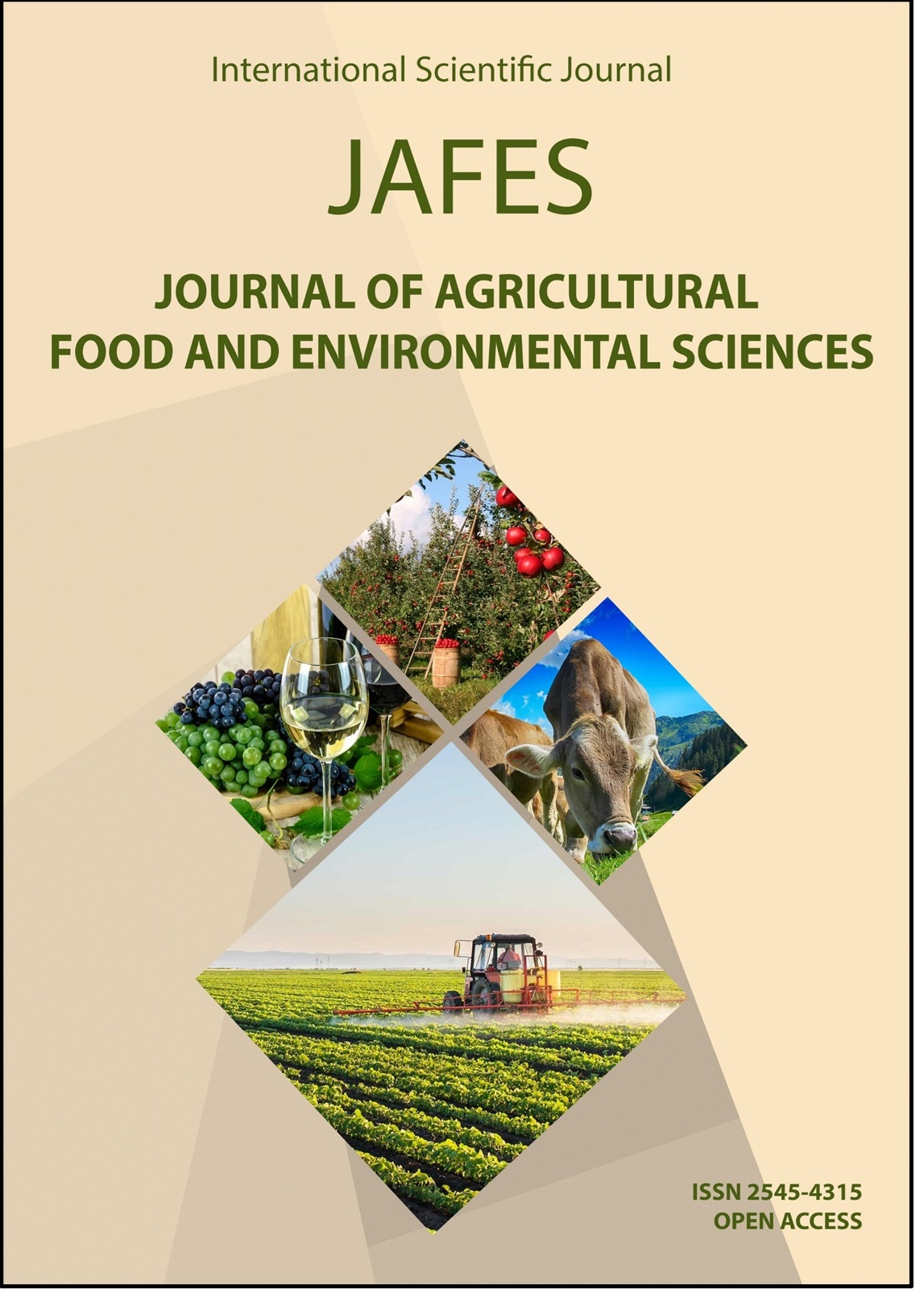CHARACTERIZATION OF CAPRIFIG (Ficus carica var. caprificus) ACCESSIONS SELECTED FROM VARIOUS LOCATIONS IN THE EASTERN MEDITERRANEAN REGION OF TURKEY
Клучни зборови:
Caprifig, morphology, location, pollinizer characteristics.Апстракт
The study was conducted to investigate the some morphological and pollinizer characteristics on caprifig accessions selected from five locations (Adana, Hatay, Kahramanmaraş, Mersin, and Osmaniye) in eastern Mediterranean region and six standard cultivars (‘Ak İlek’, ‘Armut İlek’, ‘Elma İlek’, ‘Hamza’, ‘Küçük Konkur’, and ‘Taşlık’) from Aydin location in the Aegean Region of Turkey. A total of 27 characteristics included profichi crops of caprifigs were observed in Adana (12 accessions), Hatay (37 accessions), Kahramanmaraş (17 accessions), Mersin (22 accessions), and Osmaniye (9 accessions) locations and six standard cultivars in 2014 and 2015 years. The average fruit weight per profichi crop of the cultivars (30.33 g) in Aydın location and caprifigs (27.41 g) in Hatay location were the highest compared with the caprifigs selected from Adana (23.14 g), Mersin (19.84), Kahramanmaraş (17.57 g), and Osmaniye (16.10 g) locations. The caprifigs in Mersin location had the darkness fruit skin color. The number of gall flowers was highest in cultivars (634.07), whereas the number of male flowers was found to be highest caprifigs (142.41) in Adana location. The pollen viability of caprifigs ranged between 65.76% (Mersin) and 90.51 (Cultivars). The highest of pollen number per profichi fruit were found caprifigs in Adana (824.188). The cluster analysis showed that Hatay caprifigs and standard cultivars and also Kahramanmaraş and Osmaniye caprifigs were partly similar to each other according to morphological and pollinizer characteristics.
Референци
Beck, N.G. and Lord, E.M. (1988). Breeding system in Ficus carica, the common fig. I. Floral diversity. American Journal of Botany, 75: 1904–1912.
Caliskan, O. and Polat, A.A. (2012). Morphological diversity among fig (Ficus carica L.) accessions sampled from the eastern Mediterranean region of Turkey. Turkish Journal of Agricultural and Forestry, 36: 179–193.
Caliskan, O., Bayazit, S., Ilgin, M., Kocatas, H. and Karatas, N. (2016a). Caprification and It’s Important for Edible Fig Cultivation. p.22, Hatay, Turkey
Caliskan, O., Bayazit, S., Ilgin, M., Karatas, N. and Kocatas, H. (2016b). Effects of some applications on in vitro pollen germination of caprifig genotypes (Ficus carica var. caprificus). VII. International Agricultural Symposium. Jahorina, 06-09 2016, p. 238-244, Bosnia and Herzegovina.
Condit, I.J. (1947). The fig. Waltham, Mass, Cronica Botanica, p. 222, USA.
Condit, I.J. (1955). Fig varieties: A monograph. Hilgardia, 23: 323–538.
Dokuzoguz, M. (1953). Relationship among cytological structure, pollen germination, seed formation and fruit set of some apple and pear cultivars. Ankara University press, Ankara, Turkey.
Eti, S. (1990). A practical method used to determine the amount of pollen. Cukurova University, Journal of Agricultural Faculty, 5: 49–58.
Eti, S. (1991). Determining of the capabilities of pollen viability and germination in some fruit species and cultivars via in vitro tests. Cukurova University, Journal of Agricultural Faculty, 6: 69–80.
Ferrara, G., Mazzeo, A., Pacuci, C., Matarrese, A.M.S., Tarantino, A., Crisosto, C., Incerti, O., Marcotuli, I., Nigro, D., Blanco, A. and Gadaleta, A. (2016). Characterization of edible fig germplasm from Puglia, Southern Italy: Is the distinction of three fig types (Smyrna, San Pedro and Common) still valid? Scientia Horticulturae, 205: 52–58.
Flaishman, M.A., Rover, V. and Stover, E. (2008). The fig: Botany, horticulture, and breeding. Horticultural Review, 34: 113–197.
Francis, F.J. (1980). Color quality evaluation of horticultural crops. HortScience, 15: 58–59.
Galil, J. and Ne'eman, G. (1977). Pollen transfer and pollination in the common fig (Ficus carica L.). New Phytologist, 79: 163–171
Gaaliche, B., Majdoub, A., Trad, M. and Mars, M. (2013). Assessment of pollen viability, germination, and tube growth in eight Tunisian caprifig (Ficus carica L.) cultivars. ISRN Agronomy ID 207434: 4.
Ilgin, M., Ergenoglu, F. and Caglar, S. (2007). Viability, germination and amount of pollen in selected caprifig types. Pakistan Journal of Botany, 39: 9–14.
IPGRI and CIHEAM (2003). Descriptors for Figs. International Plant Genetic Resources Institute, Rome, Italy, and International Centre for Advanced Mediterranean Agronomic Studies, Paris, France.
Khadivi-Khub, A. and Anjam, K. (2014). Characterization and evaluation of male fig (caprifig) accessions in Iran. Plant Systematics and Evolution, 10: 2177–2189.
SAS (2005). SAS online doc, version 9.1.3. SAS Inst., Cary, NC, USA.
Storey, W.B. (1975). Figs, in: Janick, J., Moore, J.N. (Eds.), Advances in. Fruit Breeding. Purdue University Press, p.568-588, West Lafayette.



